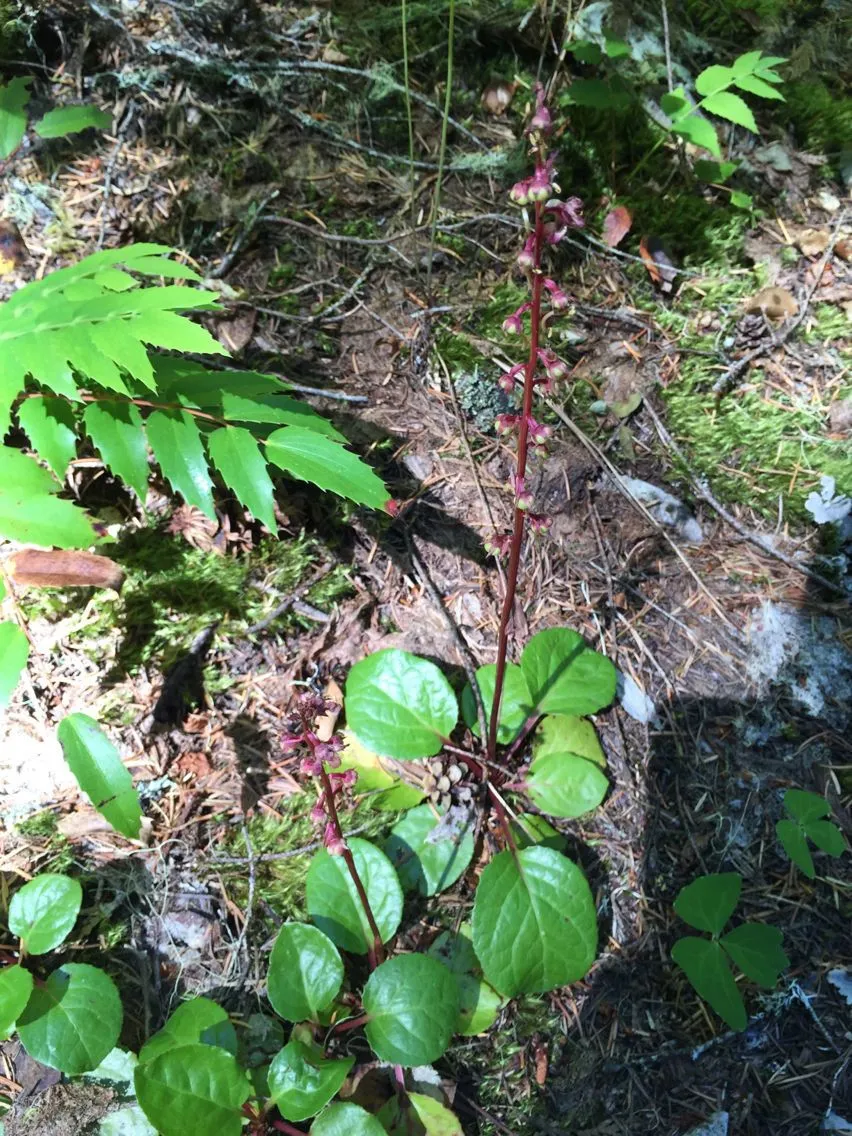
Author: Michx.
Bibliography: Fl. Bor.-Amer. 1: 251 (1803)
Year: 1803
Status: accepted
Rank: species
Genus: Pyrola
Vegetable: False
Observations: Subarctic & Temp. Asia, Subarctic & Subalpine N. America
Liver-leaf wintergreen, scientifically known as Pyrola asarifolia, is a perennial herbaceous plant that belongs to the Ericaceae family. This remarkable species is indigenous to regions characterized by cooler climates, specifically subarctic and temperate areas of Asia, as well as subarctic and subalpine territories in North America.
Michaux, a notable botanist, first documented Liver-leaf wintergreen in 1803, providing a cornerstone in botanical literature with this entry. The plant flourishes in habitats that experience low temperatures, which is evident in its widespread distribution across such diverse and harsh climates.
Typically, Pyrola asarifolia manifests as an evergreen herb, thriving under the canopy of coniferous forests and in the shaded understories of mixed woodlands. The plant is distinguished by its distinctive round, leathery leaves that possess a notable sheen, earning it the common name “Liver-leaf” due to their appearance. Its leaves are basal, meaning they grow from the base of the plant, forming a lush ground cover that persists through the year.
During the flowering season, Liver-leaf wintergreen produces delicate inflorescences — racemes of small, bell-shaped flowers ranging in color from pale pink to deep rose. These blooms stand on erect, slender stems that rise above the foliage, providing a graceful contrast against the glossy leaves. The flowers are subtle yet charming and are a crucial part of the plant’s reproductive cycle, attracting various pollinators.
The resilience and adaptability of Pyrola asarifolia make it an important species for understanding plant survival strategies in cold climates. Its ability to photosynthesize through winter and thrive in low-light conditions is remarkable, contributing to its enduring presence in its native habitats.
In summary, Liver-leaf wintergreen is a fascinating plant with a robust presence in subarctic and temperate regions, both in the Old World and the New. Its unique adaptations and aesthetic appeal underscore its importance in the ecological tapestry of wooded areas.
Eng: bog wintergreen, liver-leaf wintergreen, liverleaf wintergreen, pink wintergreen, pink pyrola, common pink wintergreen, large wintergreen, liver-leaved wintergreen, pink-flowered wintergreen
Fra: pyrole à feuilles d’asaret
En: Liver-leaf wintergreen, Liverleaf wintergreen, Bog Wintergreen, Pink Wintergreen, Alpine shinleaf, Pink pyrola, Common pink wintergreen, Large wintergreen, Liver-leaved wintergreen, Pink-flowered wintergreen, Larger Wintergreen, Round-leaved Wintergreen
Nl: Rond Wintergroen
Fr: Pyrole à feuilles d’asaret, Pirole à feuilles rondes, Pyrole à feuilles rondes
De: Rundblättriges Wintergrün
It: Piroletta a foglie rotonde
© copyright of the Board of Trustees of the Royal Botanic Gardens, Kew.
© copyright of the Board of Trustees of the Royal Botanic Gardens, Kew.
© copyright of the Board of Trustees of the Royal Botanic Gardens, Kew.
Taken Oct 25, 2022 by Joseph Littlehorn (cc-by-sa)
Taken Jul 20, 2021 by Daniel Gonzales (cc-by-sa)
Taken May 1, 2022 by allison finter (cc-by-sa)
Taken May 3, 2022 by H Lou (cc-by-sa)
Taken Aug 25, 2018 by nsahmed (cc-by-sa)
Taken Jul 18, 2021 by Brielle Quon (cc-by-sa)
Taken Jul 3, 2020 by Chaitali Saqcena (cc-by-sa)
Taken Aug 7, 2021 by fish angelina (cc-by-sa)
Taken May 24, 2020 by Jennifer Roberts (cc-by-sa)
Taken Jun 27, 2021 by Jason lester (cc-by-sa)
Taken Jul 7, 2015 by EOL − Christian Haaning (cc-by-nc)
Taken Jul 15, 2013 by EOL − faerthen (cc-by-nc)
Taken May 21, 2015 by EOL − faerthen (cc-by-nc)
Taken May 30, 2015 by EOL − Jeff Lesh (cc-by-nc)
Taken Jul 15, 2013 by EOL − Jeannette Warnert (cc-by-nc)
Taken May 30, 2015 by EOL − Jeff Lesh (cc-by-nc)
Taken Jan 28, 2014 by EOL − Erin Faulkner (cc-by-nc)
Taken Dec 14, 2014 by EOL − podiceps (cc-by-nc)
Growth habit: Subshrub
Family: Myrtaceae Author: (F.Muell.) K.D.Hill & L.A.S.Johnson Bibliography: Telopea 6: 402 (1995) Year: 1995 Status:…
Family: Rubiaceae Author: Pierre ex A.Froehner Bibliography: Notizbl. Bot. Gart. Berlin-Dahlem 1: 237 (1897) Year:…
Family: Sapindaceae Author: Koidz. Bibliography: J. Coll. Sci. Imp. Univ. Tokyo 32(1): 38 (1911) Year:…
Family: Asteraceae Author: A.Gray Bibliography: Pacif. Railr. Rep.: 107 (1857) Year: 1857 Status: accepted Rank:…
Family: Fabaceae Author: Medik. Bibliography: Vorles. Churpfälz. Phys.-Ökon. Ges. 2: 398 (1787) Year: 1787 Status:…
Family: Aspleniaceae Author: (Cav.) Alston Bibliography: Bull. Misc. Inform. Kew 1932: 309 (1932) Year: 1932…